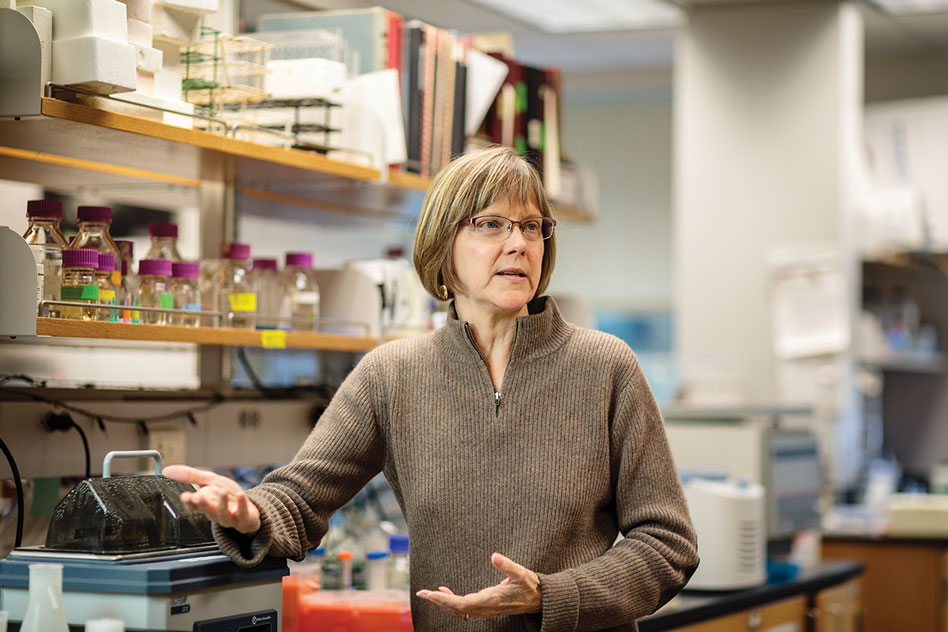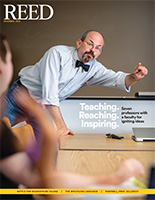
IRIS login | Reed College home Volume 95, No. 4: December 2016
Inspiring Professors (continued)

“You have a higher caliber of students at Reed. I can push the more advanced students. I come to view them more as junior colleagues. I consider my primary role here to nurture scientists.”
Photo by Leah Nash / Christopher Onstott
Janis Shampay [biology 1990–] Vollum Chair
By Romel Hernandez
The Howard Vollum Chair in Science recognizes a professor who has excelled in teaching while establishing a record of accomplishment as an experimentalist in the physical sciences. Howard Vollum ’36 was a brilliant inventor who cofounded the Tektronix Corporation.
In a Nutshell: As a young woman in 1960s Ohio, Prof. Shampay was “a total geek” who dreamed of someday working for NASA. But, like many young girls at that time, people kept steering her toward a career in nursing. Nevertheless, she chose her own path, attending Northwestern University, where she eventually traded astrophysics for biology. After earning a BA in biochemistry and molecular biology, she went on to earn a PhD in molecular biology at UC Berkeley. She learned about chromosomes from the very best, working as a grad student in the laboratory of pioneering researcher Elizabeth Blackburn, who won a Nobel Prize in 2009. Shampay was a key contributor to this groundbreaking research leading to the discovery of an enzyme in chromosomes called telomerase—a research area she continues at Reed.
“It was completely new and exciting,” Shampay recalls of her time with Blackburn, her doctorate advisor and mentor. “We found a new model for how chromosome ends are different, what makes them distinguishable.” (Blackburn mentioned Shampay’s contribution in her Nobel speech in Stockholm.) After a short stretch as a postdoc researcher at UC–San Francisco, Shampay wanted to teach, knowing that college was a place she could continue her research while involving undergraduates in the lab. She arrived at Reed in 1990, when there were relatively few women teaching in the “hard” sciences. Over the years, Shampay has received grants from the National Science Foundation and the Murdock Charitable Trust. She has been a role model for students since joining the Reed faculty.
Clawed Frogs and Telomeres: At Reed, Shampay has built on her work on telomeres, the structures that protect the ends of individual chromosomes, by studying the chromosomes of the African clawed frog. She analyzes how proteins inhibit telomerase and growth of telomeres. Though applications are far down the line, research into telomeres leads to a greater understanding of cancer growth (and the flipside, cellular aging). If scientists can figure out how to inhibit telomerase in humans, that work might point to possible antitumor treatments.
The Grand Scheme: Capping her 26th year at Reed, Shampay prides herself on a no-nonsense approach to teaching, and understands the value of encouraging students to take risks in their own lab research. “We have a saying in the department that research is teaching is research,” she says. “They inform each other . . . . Being forced to think about something other than telomeres gives me a perspective on where my work fits in the grand scheme of biology in a way that might not happen at a huge research university.”
“My favorite part of the job is seeing things start to click for students at all levels,” she says. “I enjoy having both majors and non-majors in Bio 101 and I think it’s important to reach both.”

LATEST COMMENTS
steve-jobs-1976 I knew Steve Jobs when he was on the second floor of Quincy. (Fall...
Utnapishtim - 2 weeks ago
Prof. Mason Drukman [political science 1964–70] This is gold, pure gold. God bless, Prof. Drukman.
puredog - 1 month ago
virginia-davis-1965 Such a good friend & compatriot in the day of Satyricon...
czarchasm - 4 months ago
John Peara Baba 1990 John died of a broken heart from losing his mom and then his...
kodachrome - 7 months ago
Carol Sawyer 1962 Who wrote this obit? I'm writing something about Carol Sawyer...
MsLaurie Pepper - 8 months ago
William W. Wissman MAT 1969 ...and THREE sisters. Sabra, the oldest, Mary, the middle, and...
riclf - 10 months ago